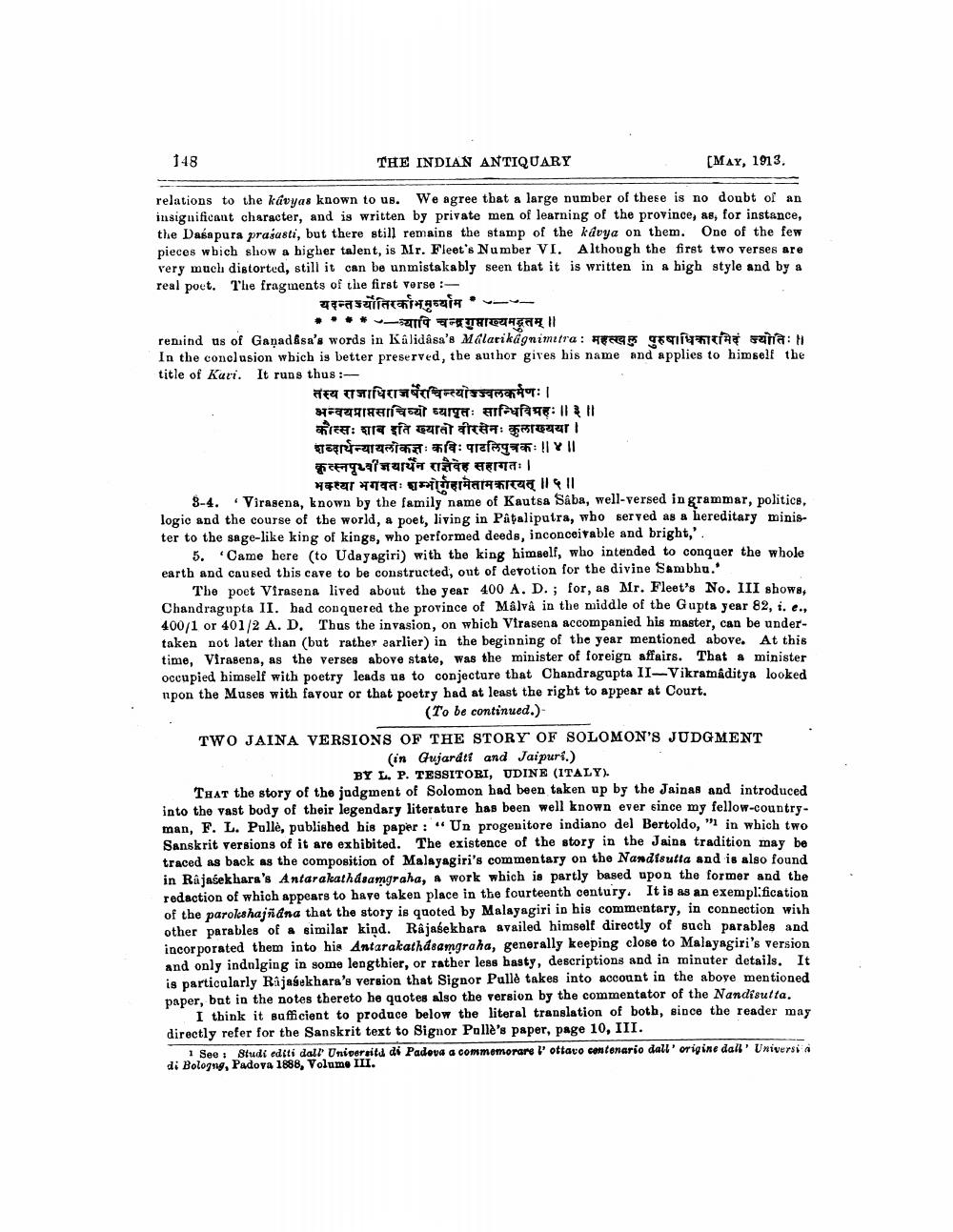________________
148
THE INDIAN ANTIQUARY
[MAY, 1913.
relations to the kávyas known to us. We agree that a large number of there is no doubt of an insignificant character, and is written by private men of learning of the province, as, for instance, the Dasapura prasasti, but there still remains the stamp of the kávya on them. One of the few pieces wbich show a higher talent, is Mr. Fleet's Number VI. Although the first two verses are very much distorted, still it can be unmistakably seen that it is written in a high style and by a real poet. The fragments of the first vorse :
yasztitaniutauit * - - ... -
THE 11 remind us of Ganadsa's words in Kalidasa's Málarikāgnimetra: ay gen tia vaina: N In the conclusion which is better preserved, the author gives his name and applies to himself the title of Kuri. It runs thus :
तस्य राजाधिराजरचिन्त्योउज्वलकर्मणः। अन्वयमाप्तसाचिव्यो व्यापृतः सान्धिविग्रहः ॥३॥ कोत्सः शाब इति ख्यातो वीरसेनः कुलाख्यया। शब्दार्थन्यायलोकज्ञः कविः पाटलिपुत्रकः॥४॥ कृत्स्नपृथ्वीजयायन राज्ञेवेह सहागतः।
भक्त्या भगवतः शम्भोगेहामेतामकारयत् ॥५॥ 8-4. Virasena, known by the family name of Kautsa Saba, well-versed in grammar, politics, logic and the course of the world, a poet, living in Patalipatra, who served as a hereditary minister to the sage-like king of kings, who performed deeds, inconceivable and bright,'
5. Came here (to Udayagiri) with the king himself, who intended to conquer the whole earth and caused this cave to be constructed, out of devotion for the divine Sambhu."
The poet Virasena lived about the year 400 A. D.; for, as Mr. Fleet's No. III shows. Chandragupta II. bad conquered the province of Mâlva in the middle of the Gupta year 82, i. e., 400/1 or 401/2 A. D. Thus the invasion, on which Vfrasena accompanied his master, can be undertaken not later than (but rather earlier) in the beginning of the year mentioned above. At this time, Virasens, as the verses above state, was the minister of foreign affairs. That a minister occupied bimself with poetry leads us to conjecture that Chandragupta II - Vikramaditya looked npon the Muses with favour or that poetry had at least the right to appear at Court.
(To be continued.) - TWO JAINA VERSIONS OF THE STORY OF SOLOMON'S JUDGMENT
(in Gujarati and Jaipur.)
BY L. P. TESSITORI, UDINE (ITALY). That the story of the judgment of Solomon had been taken up by the Jainas and introduced into the vast body of their legendary literature has been well known ever since my fellow-countryman, F. L. Pullè, published his paper : "* Un progenitore indiano del Bertoldo,” in which two Sanskrit versions of it are exhibited. The existence of the story in the Jaina tradition may be traced as back as the composition of Malayagiri's commentary on the Nandisutta and is also found in Rajasekhara's Antarakathsamgraha, a work which is partly based upon the former and the redaction of which appears to have taken place in the fourteenth century. It is as an exemplification of the paroleshajiiana that the story is quoted by Malayagiri in his commentary, in connection with other parables of a similar kind. Rajasekhara availed himself directly of such parables and incorporated them into his Antarakathdeamgraha, generally keeping close to Malayagiri's version and only indulging in some lengthier, or rather less hasty, descriptions and in minuter details. It is particularly Rajasekhara's version that Signor Palle takes into account in the above mentioned paper, but in the notes thereto he quotes also the version by the commentator of the Nandisutta.
I think it sufficient to produce below the literal translation of both, since the reader mas directly refer for the Sanskrit text to Signor Polle's paper, page 10, III.
See : Studi editi dall' Unipersita di Padova a commemorare l'ottavo centenario dall'origine dall'Universi a di Bologng, Padova 1888, Volume III.




